
The goal of South Coast Sea Urchins is to ‘garden’ the 96km of coastline between Tathra and Disaster Bay. Photo: South Coast Sea Urchins.
It’s a local seafood trader that’s been hidden in plain sight since 2005. Pambula business South Coast Sea Urchins processes 35-60 tonnes of sea urchin roe in its factory each year and yet few people know that it’s there, or have tasted the bright orange-yellow roe.
“We did a big recruitment a few months ago for our seasonal staff and that’s always what we hear: I didn’t know you existed!” says Kath Browne, who runs the business along with her husband Keith.
But the food world knows about the Brownes.
Top Australian chefs like Shannon Bennett, Maggie Beer, and Matt Preston know about the Brownes, thanks to a gold medal win at the Delicious Produce Awards in 2017.
“We have supplied, and do supply, some of the best restaurants in Australia,” Keith says with quiet pride.
South Coast Sea Urchins employs between 21-25 people for ten months of each year in its Pambula factory and is the go-to for the best roe in the business, according to Pambula chef Huw Jones, but the harvest of urchins also addresses an environmental problem: sea urchin barrens.
The purple urchins common on the Far South Coast of NSW have been in plague proportions since the 90’s, creating ‘barrens’ on the seafloor where hungry urchins have stripped all the seaweed and algae and even eaten into the rock, Keith says.
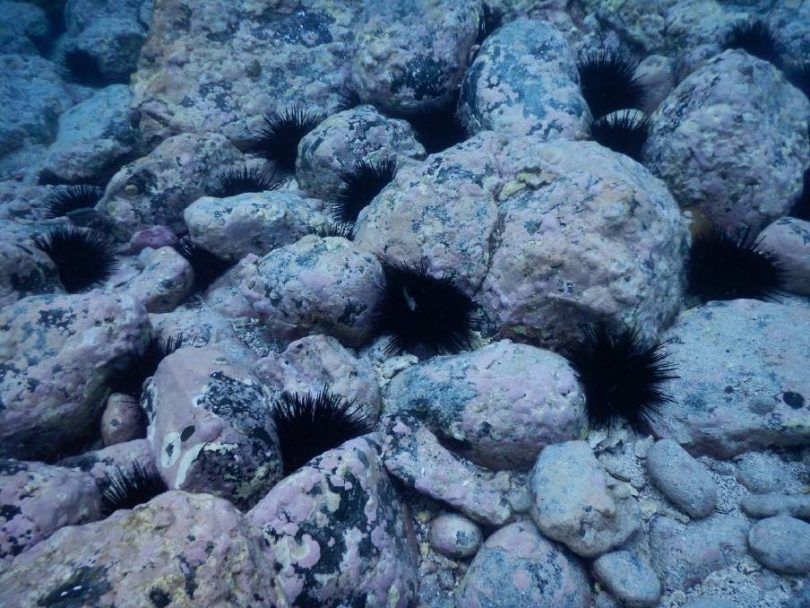
Purple urchins common on the Far South Coast of NSW have been in plague proportions since the 90’s. Photo: Bill Barker, Nature Coast Marine Group.
According to Keith, one reason for the plagues is that lobsters [which prey on urchins] were fished too hard in the 50’s and 60’s.
The goal of South Coast Sea Urchins is to ‘garden’ the 96km of coastline between Tathra and Disaster Bay, selectively thinning urchins and propagating different seaweeds to encourage diversity on the reef – which also happens to improve the quality of urchin roe, increasing the amount of top-grade roe, known as uni.
Uni is prized in Japan and Italy and often eaten raw, while Kina is packed in brine and is popular with Pacific Islanders, Keith says. South coast Sea Urchins handles both grades.
The Brownes have employed Indigenous Australians in their factory and Keith was surprised to hear from them that sea urchins don’t seem to have been eaten much historically.
“One Koori guy told me that you can’t just throw an urchin on the fire [the roe melts] so it wasn’t eaten much. But he tried some and said, “that’s pretty bloody good, isn’t it?”
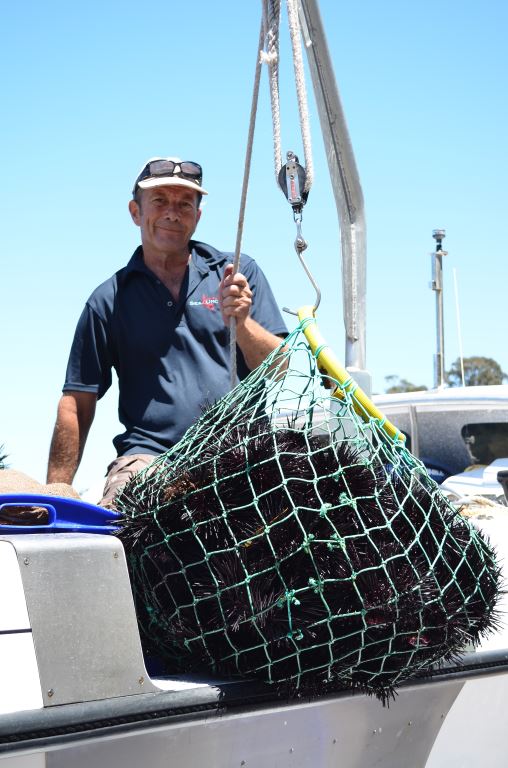
All in a days work, Andrew Curtis in Eden. Photo: South Coast Sea Urchins.
Keith encourages his divers to come into the factory and try the product so they can make the connection between where the animal was harvested and the texture and flavour.
“When the urchins feed on certain weeds, it changes the colour and flavour of the roe,” Keith says. “If you can get the roe an apricot colour, every chef wants that.”
“Keith has always had that big picture in mind,” says Kath.
As he points to some before and after photos of a sea urchin barren he and his divers have worked on, Keith’s passion for returning reefs to a balanced ecosystem is obvious.
“You can see these dark patches on the rock where algae and weed are returning,” he says, pointing to the ‘after’ picture. “I’m an ab diver too, so I’m invested on a few levels.”
Keith adds that “seeing the change in an environment after only 12 months is the exciting part of the job. You dive an area you harvested a year before and it’s unrecognizable because the seaweed has grown so much.”
But the trajectory of South Coast Sea Urchins’ growth has not been without its setbacks.
A storm in June 2016 “wiped out 50 per cent of our biomass and killed everything,” Keith says.
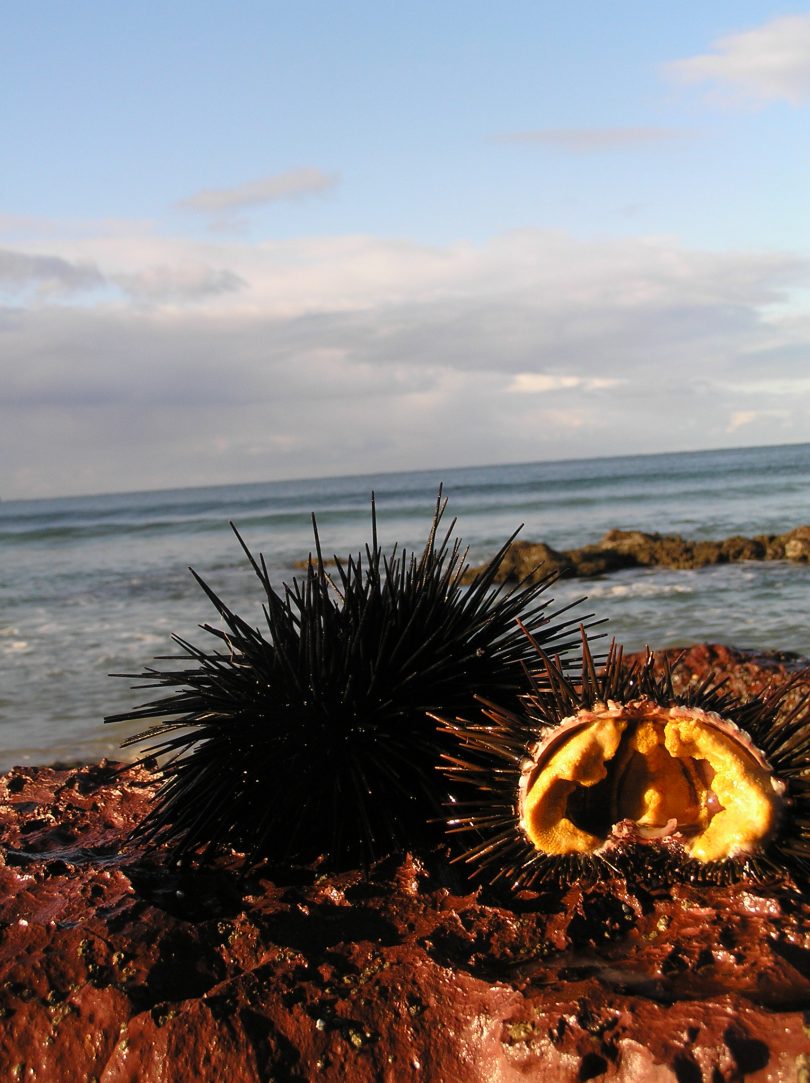
Keith Browne suggests letting urchin roe melt onto a hot steak, or battering it in tempura and deep frying. Photo: South Coast Sea Urchins.
Walking the coastline after the storm and speaking to fisheries employees, Keith knew it was bad news for his business: “Fisheries told me there were abalone in the bush up and down the coast. If a storm is rough enough to rip an abalone from a rock, it’s pretty destructive.”
Rehabilitating urchin barrens is a long-range project and inherent to the timeline is risk.
The storm didn’t only wipe out Keith’s next harvest, it wiped out ten years of hard work by Keith and his divers – a situation comparable to a farmer having all her topsoil wash away in a flood.
A conversation with Japanese – Australian clients early in the life of the business showed Keith just how long it could take to achieve the premium quality and price he was looking for.
“They said to contact them in seven years and now I see why,” Keith says wryly. “We started in 2005 with 9 per cent uni and right before the storm we were at around 60 per cent uni.”
Disappointed is an understatement for how the Brownes felt after the storm.
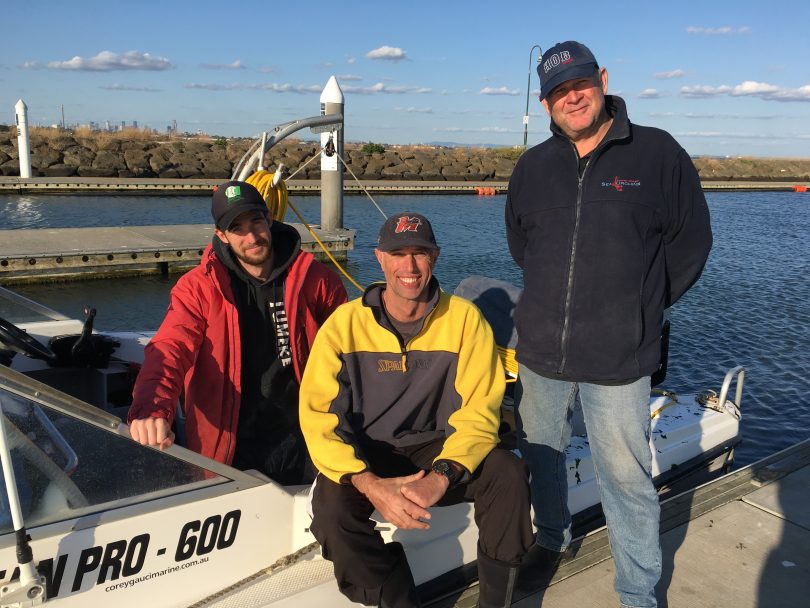
Left to right: Dalton Browne, John Mineham, Keith Browne at one of the dive locations in Port Phillip Bay, Melbourne. Photo: South Cost Sea Urchins.
Rather than walk away from their business, the Brownes decided they would do whatever it took to stay afloat, so for the last two years they have been sourcing urchins from Port Phillip Bay near Melbourne, and also from the coast near Mallacoota while they rest their South Coast fishery.
Port Phillip Bay urchins are white, not purple and tend to be sweeter, Keith says.
“It’s hard to describe a flavour,” Keith laughs “but I’d say that the roe is salty, like most seafood and then the purple urchin roe has an iodine background while the white urchin we harvest in Port Phillip Bay has a sweeter finish.”
He suggests letting urchin roe melt onto a hot steak, or battering it in tempura and deep frying, “It goes creamy, like camembert,” he says.
Chef Huw Jones, who owned Zanzibar restaurant in Merimbula until last year, has served South Coast Sea Urchins roe in his restaurant and is a fan himself.
But Jones acknowledges that it’s a hard sell for people who haven’t tried it, as it’s not even the eggs of the animal we’re eating, but the gonads.
“It’s not like an oyster or a mussel where you’re eating the whole animal,” Jones explains, “and because it’s not a muscle you’re eating, the texture is very soft so that’s surprising to many people.”
Jones says that the work the Brownes have done to develop the market and processing techniques make the product well worth the price.
“One reason people don’t eat urchin roe widely is because it’s a real skill to choose urchin that are full and then to clean the roe from the rest of the animal,” Jones says.
“Any diver can go out there and get urchin,” he says, “but to know what you’re looking for and clean them up – it’s a lot of work.”
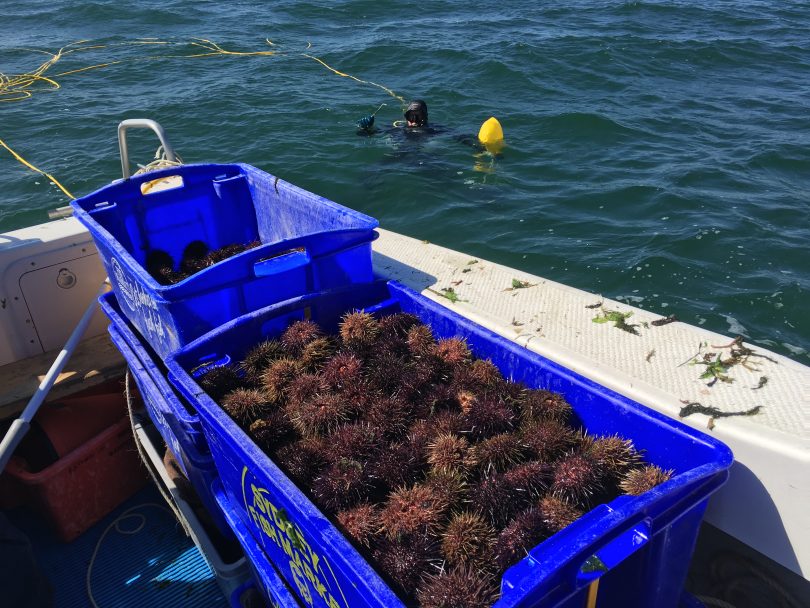
Pambula business South Coast Sea Urchins processes 35-60 tonnes of sea urchin roe in its factory each year. Photo: South Coast Sea Urchins.
Despite it all, the Brownes are still hooked. A recent investigative dive on the south coast showed Keith that his patience has paid off and he is hoping to begin harvesting urchins again from the storm-destroyed stretches of coast next month.
“Nature has a balancing effect,” Keith muses, “there are actually white urchins returning along with the more common purple ones, as well as increased numbers of mussels and whelks.”
Keith shrugs and looks around his factory office, plastered with pictures of his beloved sea world.
“Nature is pretty generous,” he says with a small smile.
Original Article published by Elka Wood on About Regional.












